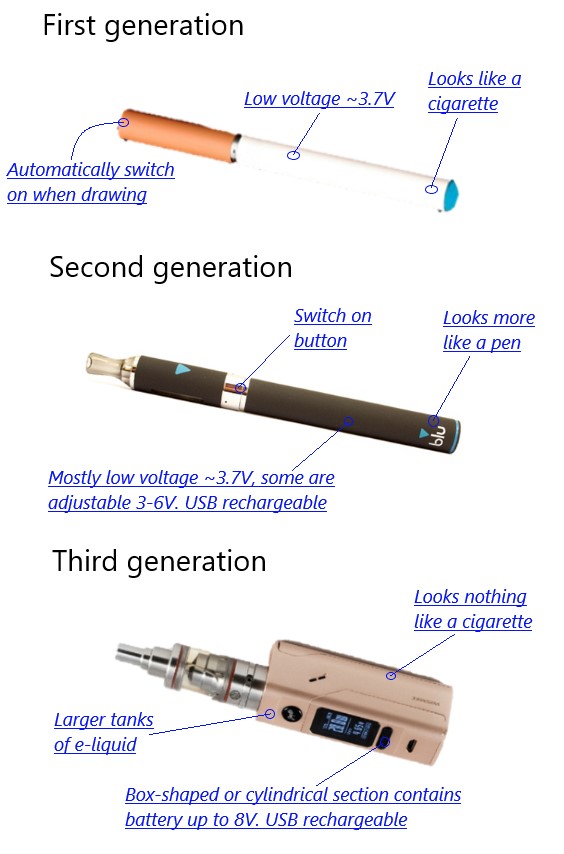New evidence shows that electronic cigarettes, when used together with behavioural support, enable substantially more smokers to give up than nicotine replacement treatments accompanied by the same behavioural support. About 1 in 10 smokers randomised to usual care including nicotine replacement therapy succeeding in quitting long-term compared to nearly 2 in 10 of those randomised to electronic cigarettes.
The benefits of quitting smoking
An NHS website lists ten health benefits from stopping smoking. They include the obvious: “ex-smokers have whiter teeth and sweeter breath” and “Stopping smoking lets you breathe more easily”; the sexy: ex-smokers have “younger looking skin” and “improved fertility”, and “quitting leads to better sex”; and the bottom line: “quit smoking to live longer”. The latter has been shown in two huge British studies. 50 years of follow-up of nearly 35,000 male British doctors showed that quitting smoking at age 30, 40, 50 or 60 led to gains of 10, 9, 6 or 3 years of life-expectancy respectively. In females, the Million Women Study followed nearly 1.2 million women for up to 12 years. They estimated that smokers (who did not quit) reduced their life-expectancy by 11 years. Continuing smokers had three times the risk of dying during the study compared to never smokers, whereas women who quit by age 45 only had 1.2 times the risk of never smokers.
Together these results make clear the huge benefits of enabling smokers to quit.
Study design
This study was a randomised controlled trial – considered to be the gold-standard in generation of evidence. Just under 900 smokers attending an NHS Stop Smoking Service clinic agreed to participate and were randomised to either nicotine replacement of their choice or an e-cigarette starter pack. The starter pack included a second-generation electronic cigarette and a single bottle of nicotine e-liquid. Participants in both arms also received behavioural support once a week for at least four weeks. The idea was to help people quit smoking completely. This was assessed at 12 months both by asking participants and then verifying the results by looking for carbon monoxide in a breath test. Only smokers have carbon monoxide in their breath.

What did we find?
At 12 months, 18% (79/438) of the smokers given electronic cigarettes had stopped smoking completely compared with 10% (44/446) of those given nicotine replacement therapy. Such a big difference is extremely unlikely to be due to chance. Even among those who didn’t succeed in quitting, greater numbers (n=44) managed to reduce their smoking (and carbon monoxide levels) by at least 50% in the vaping arm compared with the nicotine replacement arm (n=29).
There were other differences between the two arms of the trial too. Most notably nearly 80% of those who quit in the e-cigarette arm still used e-cigarettes at 12 months, but fewer than 10% of those who quit in the nicotine replacement arm, used a nicotine replacement product (such as a patch or gum) at 12 months. This helps explain why more smokers in the e-cigarette arm were successful in quitting, but it could also be a bad thing. Will these ex-smokers remain addicted to the nicotine in vaping for the rest of their lives? Will they have worse health compared to ex-smokers who quit completely? On the other hand, this could also be a good thing if it prevents irritability and weight gain that normally accompany smoking cessation and especially if it helps people who were previously heavily dependent on cigarettes to avoid relapse and remain smoke-free.
An unexpected find was that participants offered e-cigarettes reported a greater decline in cough and phlegm. For instance, at baseline about 43% of participants in both arms reported phlegm production and this reduced to 25% in the e-cigarette arm compared with 37% in the nicotine replacement arm. We’ll study this further in future.
How do e-cigarettes work?
People using electronic cigarettes inhale nicotine in a vapour rather than smoke. That’s why it’s called vaping as opposed to smoking! Nicotine is the addictive component of tobacco. So, vaping can help manage nicotine cravings.
Not all e-cigarettes are the same and not all e-liquids are the same. If you are using e-cigarettes to try to stop smoking it is important to find a flavour that you like and even more important to choose a strength of e-liquid that satisfies you
What does this mean?
Vaping remains controversial in public health circles, especially in USA. A recent US report emphasises that “Among youth — who use e-cigarettes at higher rates than adults do — there is substantial evidence that e-cigarette use increases the risk of transitioning to smoking conventional cigarettes.” The statement is based on studies showing that young people who try one product (e-cigarettes or cigarettes) also try the other one, but it contradicts the fact that smoking among US youth continues to decline at unprecedented rates. Here in the UK, the attitude to vaping is much more positive. A report for Public Health England states “vaping poses only a small fraction of the risks of smoking and switching completely from smoking to vaping conveys substantial health benefits”.
Of course, this study says nothing about whether widespread availability of electronic cigarettes in our society will result in fewer or more young people taking up tobacco smoking. Other studies that monitor smoking prevalence among young people do that, and they show that up to now, the rise of vaping has been accompanied by a distinct decline in smoking. What our study shows is that including e-cigarettes among treatment options is likely to improve the efficacy of stop smoking services and reduce their cost.
The views expressed are those of the author. Posting of the blog does not signify that the Cancer Prevention Group endorse those views or opinions.


Pingback: The Mysterious Case of an American Epidemic of Vaping-Related Lung Injuries – Cancer Prevention Group Blog